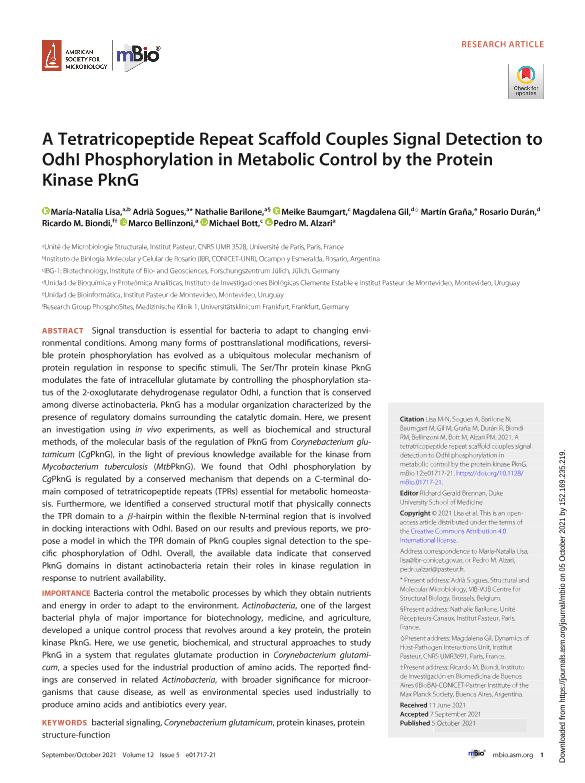Mostrar el registro sencillo del ítem
dc.contributor.author
Lisa, María Natalia

dc.contributor.author
Sogues, Adrià
dc.contributor.author
Barilone, Nathalie
dc.contributor.author
Baumgart, Meike
dc.contributor.author
Gil, Magdalena

dc.contributor.author
Graña, Martín
dc.contributor.author
Durán, Rosario
dc.contributor.author
Biondi, Ricardo Miguel

dc.contributor.author
Bellinzoni, Marco
dc.contributor.author
Bott, Michael
dc.contributor.author
Alzari, Pedro M.
dc.date.available
2023-01-26T17:58:51Z
dc.date.issued
2021-10
dc.identifier.citation
Lisa, María Natalia; Sogues, Adrià; Barilone, Nathalie; Baumgart, Meike; Gil, Magdalena; et al.; A Tetratricopeptide Repeat Scaffold Couples Signal Detection to OdhI Phosphorylation in Metabolic Control by the Protein Kinase PknG; American Society for Microbiology; MBio; 12; 5; 10-2021; 1-14
dc.identifier.issn
2161-2129
dc.identifier.uri
http://hdl.handle.net/11336/185822
dc.description.abstract
Signal transduction is essential for bacteria to adapt to changing environmental conditions. Among many forms of posttranslational modifications, reversible protein phosphorylation has evolved as a ubiquitous molecular mechanism of protein regulation in response to specific stimuli. The Ser/Thr protein kinase PknG modulates the fate of intracellular glutamate by controlling the phosphorylation status of the 2-oxoglutarate dehydrogenase regulator OdhI, a function that is conserved among diverse actinobacteria. PknG has a modular organization characterized by the presence of regulatory domains surrounding the catalytic domain. Here, we present an investigation using in vivo experiments, as well as biochemical and structural methods, of the molecular basis of the regulation of PknG from Corynebacterium glutamicum (CgPknG), in the light of previous knowledge available for the kinase from Mycobacterium tuberculosis (MtbPknG). We found that OdhI phosphorylation by CgPknG is regulated by a conserved mechanism that depends on a C-terminal domain composed of tetratricopeptide repeats (TPRs) essential for metabolic homeostasis. Furthermore, we identified a conserved structural motif that physically connects the TPR domain to a b-hairpin within the flexible N-terminal region that is involved in docking interactions with OdhI. Based on our results and previous reports, we propose a model in which the TPR domain of PknG couples signal detection to the specific phosphorylation of OdhI. Overall, the available data indicate that conserved PknG domains in distant actinobacteria retain their roles in kinase regulation in response to nutrient availability. IMPORTANCE Bacteria control the metabolic processes by which they obtain nutrients and energy in order to adapt to the environment. Actinobacteria, one of the largest bacterial phyla of major importance for biotechnology, medicine, and agriculture, developed a unique control process that revolves around a key protein, the protein kinase PknG. Here, we use genetic, biochemical, and structural approaches to study PknG in a system that regulates glutamate production in Corynebacterium glutamicum, a species used for the industrial production of amino acids. The reported findings are conserved in related Actinobacteria, with broader significance for microorganisms that cause disease, as well as environmental species used industrially to produce amino acids and antibiotics every year.
dc.format
application/pdf
dc.language.iso
eng
dc.publisher
American Society for Microbiology

dc.rights
info:eu-repo/semantics/openAccess
dc.rights.uri
https://creativecommons.org/licenses/by/2.5/ar/
dc.subject
BACTERIAL SIGNALING
dc.subject
CORYNEBACTERIUM GLUTAMICUM
dc.subject
PROTEIN KINASES
dc.subject
PROTEIN STRUCTURE-FUNCTION
dc.subject.classification
Bioquímica y Biología Molecular

dc.subject.classification
Ciencias Biológicas

dc.subject.classification
CIENCIAS NATURALES Y EXACTAS

dc.title
A Tetratricopeptide Repeat Scaffold Couples Signal Detection to OdhI Phosphorylation in Metabolic Control by the Protein Kinase PknG
dc.type
info:eu-repo/semantics/article
dc.type
info:ar-repo/semantics/artículo
dc.type
info:eu-repo/semantics/publishedVersion
dc.date.updated
2022-09-19T16:02:42Z
dc.identifier.eissn
2150-7511
dc.journal.volume
12
dc.journal.number
5
dc.journal.pagination
1-14
dc.journal.pais
Estados Unidos

dc.description.fil
Fil: Lisa, María Natalia. Consejo Nacional de Investigaciones Científicas y Técnicas. Centro Científico Tecnológico Conicet - Rosario. Instituto de Biología Molecular y Celular de Rosario. Universidad Nacional de Rosario. Facultad de Ciencias Bioquímicas y Farmacéuticas. Instituto de Biología Molecular y Celular de Rosario; Argentina. Instituto Pasteur; Francia
dc.description.fil
Fil: Sogues, Adrià. Instituto Pasteur; Francia
dc.description.fil
Fil: Barilone, Nathalie. Instituto Pasteur; Francia
dc.description.fil
Fil: Baumgart, Meike. Institute of Bio- and Geosciences; Alemania
dc.description.fil
Fil: Gil, Magdalena. Instituto de Investigaciones Biológicas "Clemente Estable"; Uruguay. Instituto Pasteur de Montevideo; Uruguay
dc.description.fil
Fil: Graña, Martín. Instituto Pasteur de Montevideo; Uruguay
dc.description.fil
Fil: Durán, Rosario. Instituto Pasteur de Montevideo; Uruguay
dc.description.fil
Fil: Biondi, Ricardo Miguel. Universitätsklinikum Frankfurt; Alemania. Consejo Nacional de Investigaciones Científicas y Técnicas. Oficina de Coordinación Administrativa Parque Centenario. Instituto de Investigación en Biomedicina de Buenos Aires - Instituto Partner de la Sociedad Max Planck; Argentina
dc.description.fil
Fil: Bellinzoni, Marco. Institut Pasteur de Paris.; Francia
dc.description.fil
Fil: Bott, Michael. Institute of Bio- and Geosciences; Alemania
dc.description.fil
Fil: Alzari, Pedro M.. Institut Pasteur de Paris.; Francia
dc.journal.title
MBio
dc.relation.alternativeid
info:eu-repo/semantics/altIdentifier/url/https://journals.asm.org/doi/10.1128/mBio.01717-21
dc.relation.alternativeid
info:eu-repo/semantics/altIdentifier/doi/http://dx.doi.org/10.1128/mBio.01717-21
Archivos asociados
